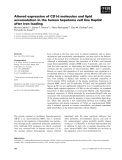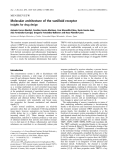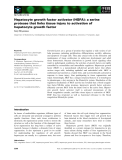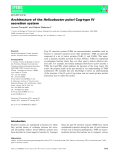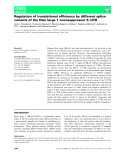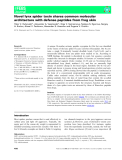
Molecular architecture
-
Iron overload in the liver may occur in clinical conditions such as hemo-chromatosis and nonalcoholic steatohepatitis, and may lead to the deterior-ation of the normal liver architecture by mechanisms not well understood. Although a relationship between the expression of ICAM-1, and classical major histocompatibility complex (MHC) class I molecules, and iron over-load has been reported, no relationship has been identified between iron overload and the expression of unconventional MHC class I molecules....
 14p
14p  awards
awards
 05-04-2013
05-04-2013
 32
32
 4
4
 Download
Download
-
The transient receptor potential channel vanilloid receptor subunit 1 (TRPV1) is amolecular integrator of physical and chemical stimuli in the peripheral nociceptor terminals. TRPV1 is an ionotropic channel that plays a critical role in both thermal nociception and inflammatoryhyperalgesia. Structure–function relationships are providing fundamental insights of the modular architecture of this neuronal recep-tor.
 7p
7p  dell39
dell39
 03-04-2013
03-04-2013
 46
46
 3
3
 Download
Download
-
Growth factors are a group of proteins that regulate a wide variety of cel-lular processes, including proliferation, differentiation, motility, adhesion, and apoptosis of target cells. They play crucial roles in the formation and maintenance of tissue architecture in embryonic development and adult tissue homeostasis.
 7p
7p  mobifone23
mobifone23
 21-01-2013
21-01-2013
 40
40
 5
5
 Download
Download
-
c-Glutamyltranspeptidase (GGT; EC 2.3.2.2), an enzyme found in organ-isms from bacteria to mammals and plants, plays a central role in glutathi-one metabolism. Structural studies of GGTs from Escherichia coliand Helicobacter pylori have revealed detailed molecular mechanisms of catalysis and maturation.
 10p
10p  mobifone23
mobifone23
 18-01-2013
18-01-2013
 51
51
 5
5
 Download
Download
-
Type IV secretion systems (T4SS) are macromolecular assemblies used by bacteria to transport material across their membranes. T4SS are generally composed of a set of twelve proteins (VirB1–11 and VirD4). This repre-sents a dynamic machine powered by three ATPases.
 10p
10p  cosis54
cosis54
 05-01-2013
05-01-2013
 43
43
 5
5
 Download
Download
-
Human Disc large (DLG1) has been demonstrated to be involved in the control of cell polarity and maintenance of tissue architecture, and is fre-quently lost in human tumours. However, the mechanisms controlling DLG1 expression are poorly understood.
 13p
13p  cosis54
cosis54
 05-01-2013
05-01-2013
 35
35
 3
3
 Download
Download
-
A unique 30-residue cationic peptide oxyopinin 4a (Oxt 4a) was identified in the venom of the lynx spider Oxyopes takobius(Oxyopidae). Oxt 4a con-tains a single N-terminally located disulfide bond, Cys4–Cys10, and is structurally different from any spider toxin studied so far.
 12p
12p  cosis54
cosis54
 09-12-2012
09-12-2012
 32
32
 3
3
 Download
Download
CHỦ ĐỀ BẠN MUỐN TÌM









